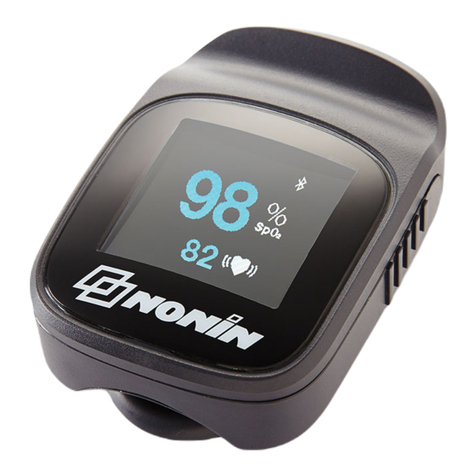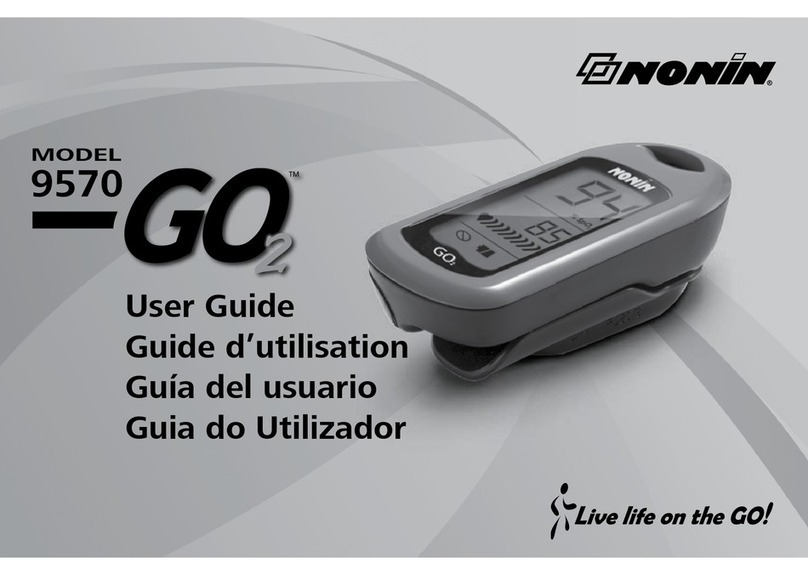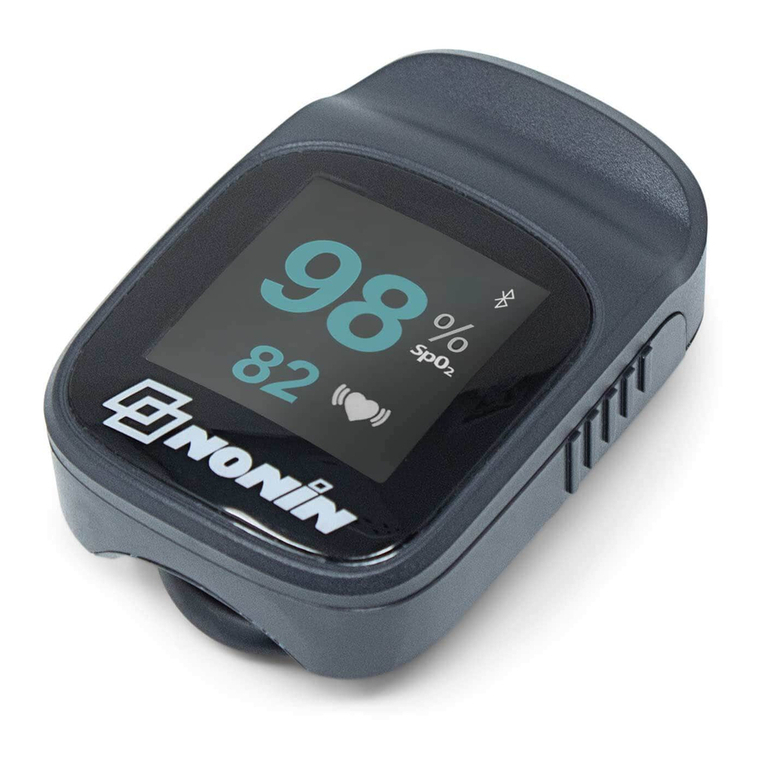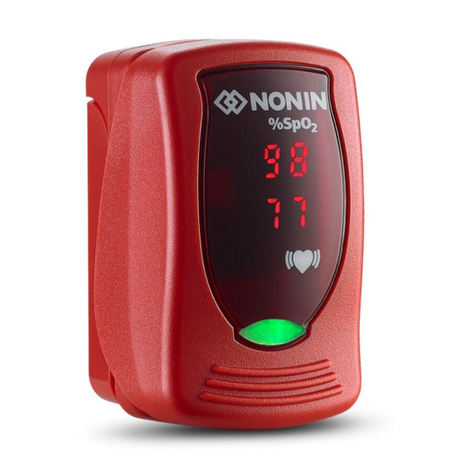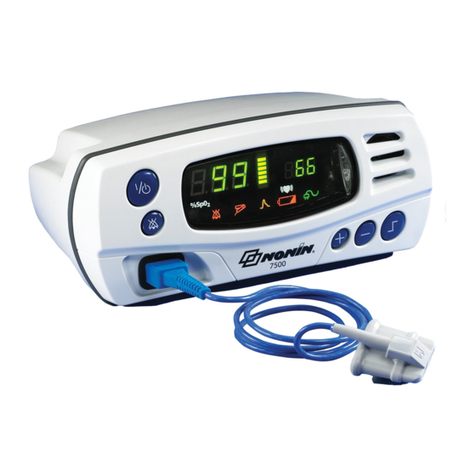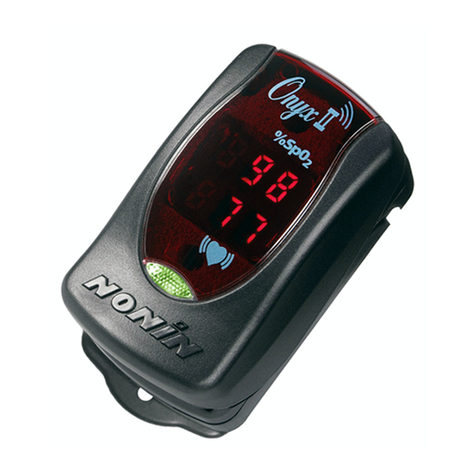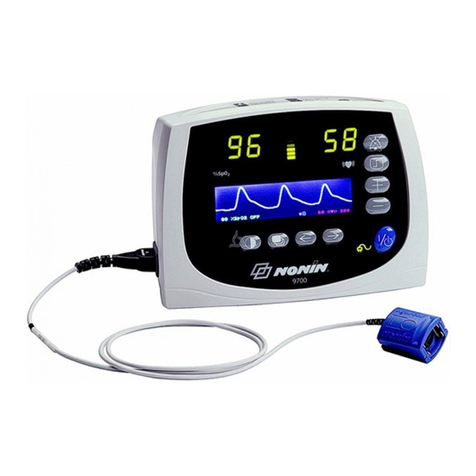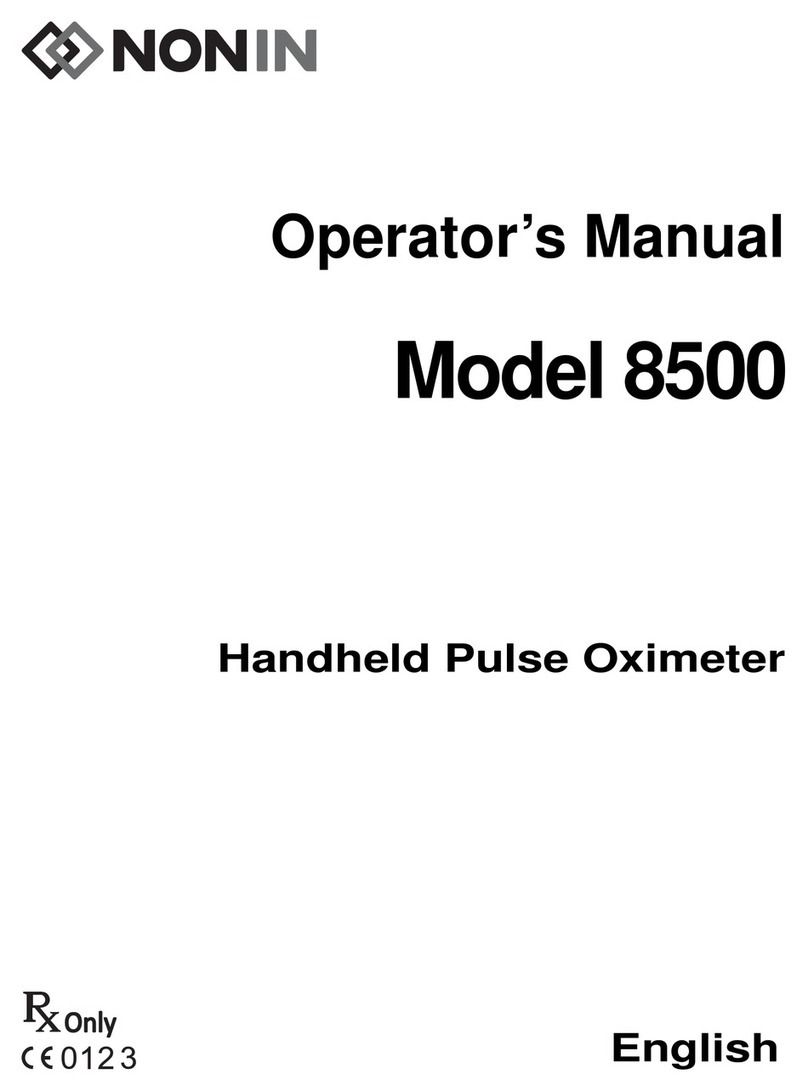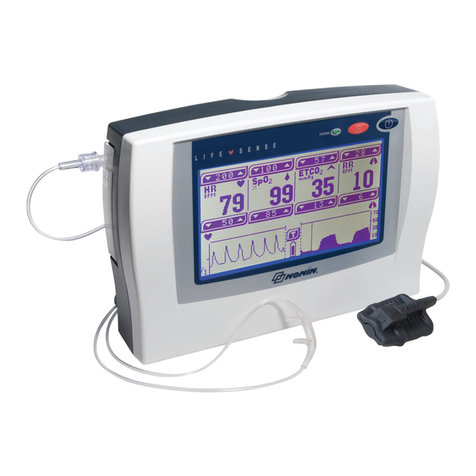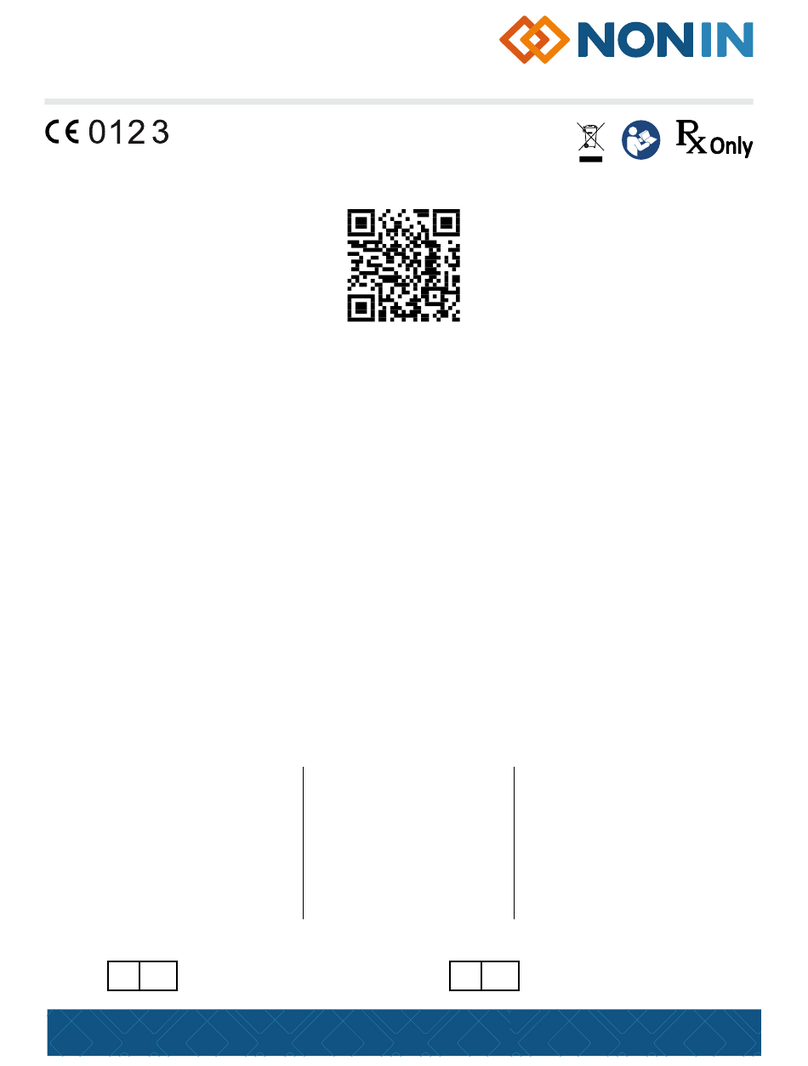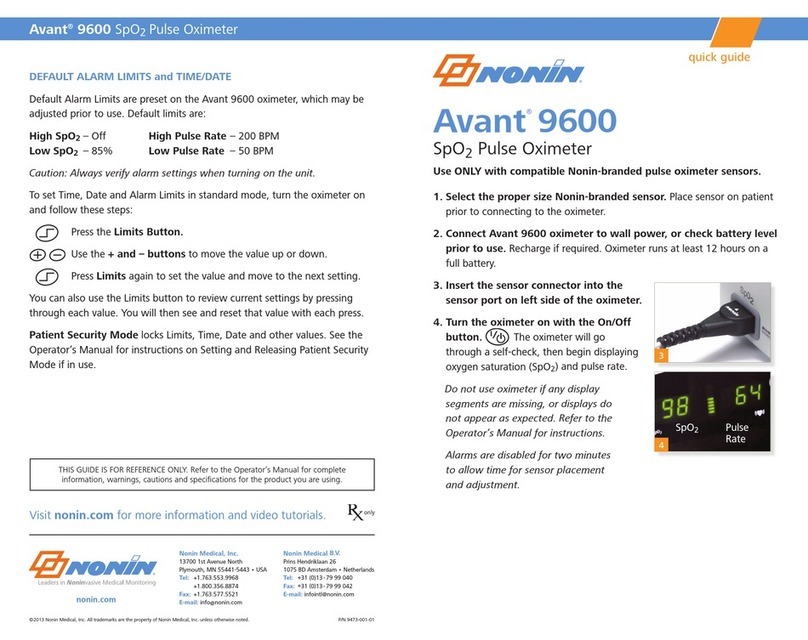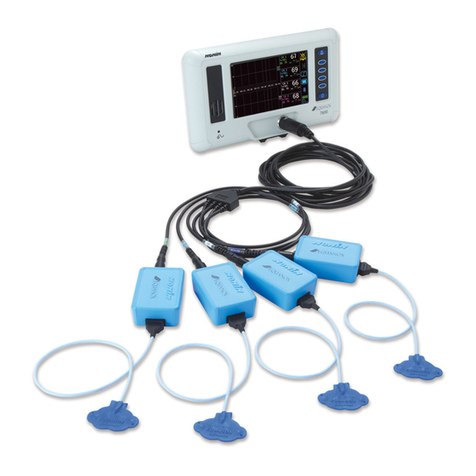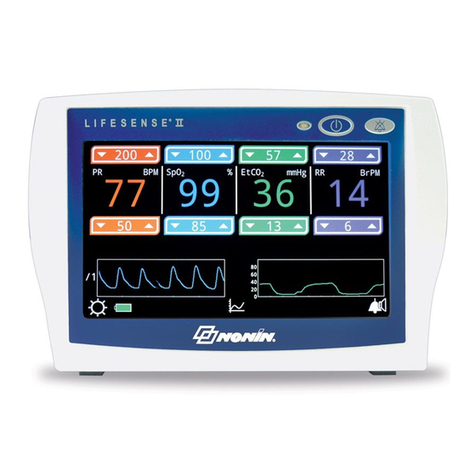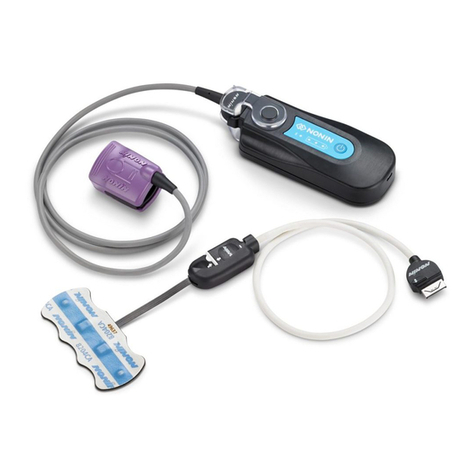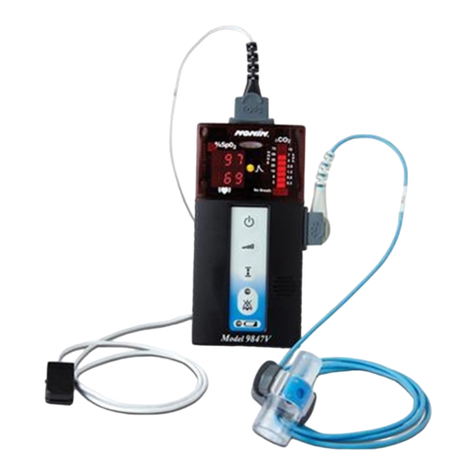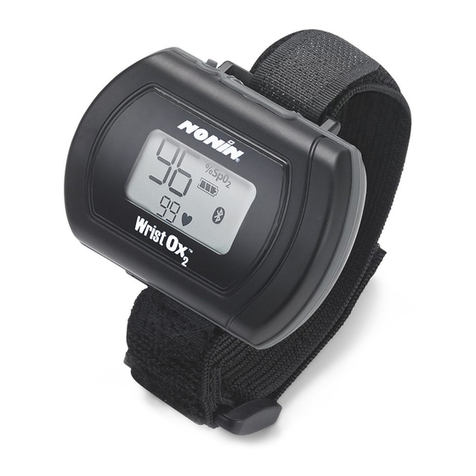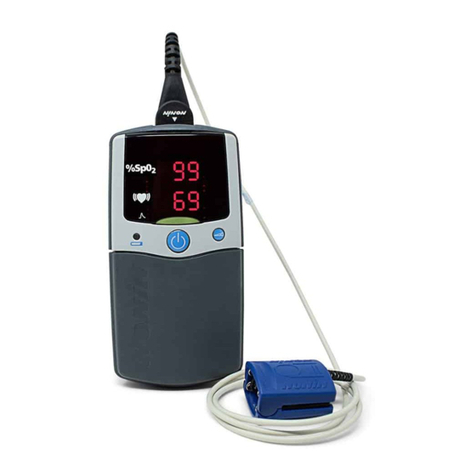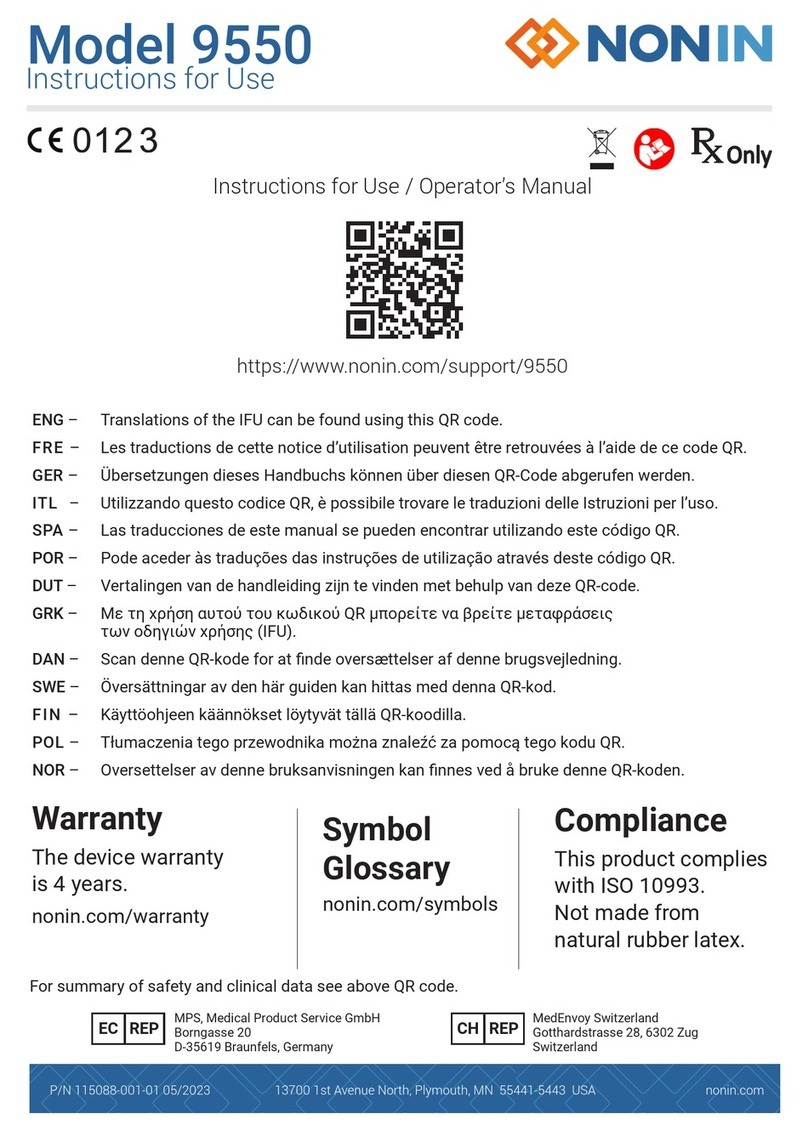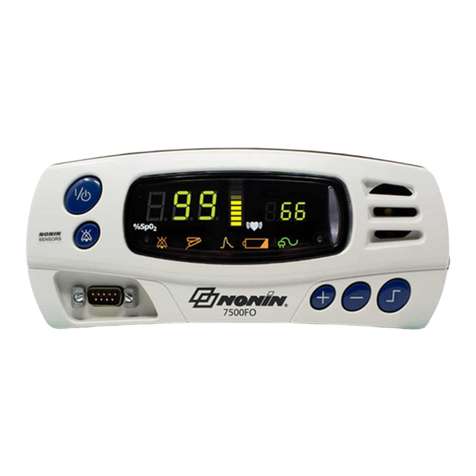
© 2016 Nonin Medical, Inc.
7750-101-06
MPS, Medical Product Service GmbH
Borngasse 20
D-35619 Braunfels, Germany
Nonin and Onyx are registered trademarks of Nonin Medical, Inc.
U.S. Patents 5,490,523; 5,792,052
EC
REP
Nonin Medical, Inc.
13700 1st Avenue North
Plymouth, Minnesota 55441, USA
nonin.com
+1 (763) 553-9968 (outside US and Canada)
+31 (0)13 - 79 99 040 (Europe)
(800) 356-8874 (US and Canada)
Fax: +1 (763) 553-7807
+31 (0)13 - 79 99 042 (Europe)
Instructions for Use
Onyx®II Model 9550 Finger Pulse Oximeter
Indications for Use
The Nonin®Onyx II Model 9550 Finger Pulse Oximeter is a small, lightweight, portable
device indicated for use in measuring and displaying functional oxygen saturation of
arterial hemoglobin (%SpO2) and pulse rate of patients who are well or poorly
perfused. It is intended for spot-checking of adult and pediatric patients on fingers
(other than the thumb) between 0.3 – 1.0 inch (0.8 – 2.5 cm) thick. The device’s
intended use environments include hospitals, clinics, long-term care facilities, skilled
nursing facilities, emergency medical services, and home healthcare services.
Warnings
• Do not use the device in an MR environment, in an explosive atmosphere, or on infant or neonatal
patients.
• This device is not defibrillation proof per IEC 60601-1
• Inspect the sensor application site at least every 4 hours to ensure correct sensor alignment and
skin integrity. Patient sensitivity to the sensor may vary due to medical status or skin condition.
• Avoid excessive pressure to the sensor application site as this may cause damage to the skin
beneath the sensor.
• This device is intended only as an adjunct in patient assessment. It must be used in conjunction
with other methods of assessing clinical signs and symptoms.
• The device must be able to measure the pulse properly to obtain an accurate SpO2measurement.
Verify that nothing is hindering the pulse measurement before relying on the SpO2measurement.
• Operation of this device below the minimum amplitude of 0.3% modulation may cause inaccurate
results.
• General operation of the device may be affected by the use of an electrosurgical unit (ESU).
• The use of accessories other than those specified in these instructions may result in increased
electromagnetic emission and/or decreased immunity of this device.
• This device should not be used adjacent to or stacked with other equipment. If adjacent or stacked
use is necessary, the device should be observed carefully to verify normal operation.
• Keep the oximeter away from young children. Small items such as the battery door, battery, and
lanyard are choking hazards.
• Certain activities may pose a risk of injury, including strangulation, if lanyard should become
wrapped around your neck.
• Before changing batteries, make sure the device is off and is not applied to a digit.
Cautions
• This device has no audible alarms and is intended only for spot-checking.
• This device is designed to determine the percentage of arterial oxygen saturation of functional
hemoglobin. Factors that may degrade pulse oximeter performance or affect the accuracy of the
measurement include the following:
• The device may not work when circulation is reduced. Warm or rub the finger, or re-position
the device.
• This device’s display will go blank after 30 seconds of no readings or poor readings.
• In some circumstances, the device may interpret motion as good pulse quality. Minimize patient
motion as much as possible.
• Cardiogreen and other intravascular dyes may affect the accuracy of the SpO2measurement.
• Clean the device before applying it to a new patient.
• Do not sterilize, autoclave, or immerse this device in liquid. Do not pour or spray any liquids onto
the device.
• Do not use caustic or abrasive cleaning agents, or any cleaning agent containing ammonium
chloride or isopropyl alcohol.
• This device is a precision electronic instrument and must be repaired by Nonin Technical Service.
Field repair of the device is not possible. Do not attempt to open the case or repair the electronics.
Opening the case may damage the device and void the warranty.
• A flexible circuit connects the two halves. Do not twist or pull the flexible circuit or overextend the
device’s spring.
• Do not hang the lanyard from the device’s flexible circuit.
•
A functional tester cannot be used to assess the accuracy of a pulse oximeter monitor or sensor.
•
This equipment complies with IEC 60601-1-2 for electromagnetic compatibility for medical electrical
equipment and/or systems. This standard is designed to provide reasonable protection against
harmful interference in a typical medical installation. However, because of the proliferation of radio-
frequency transmitting equipment and other sources of electrical noise in healthcare and other
environments, it is possible that high levels of such interference due to close proximity or strength of
a source might disrupt the performance of this device. Medical electrical equipment needs special
precautions regarding EMC, and all equipment must be installed and put into service according to the
EMC information specified in this manual.
• Portable and mobile RF communications equipment can affect medical electrical equipment.
• Batteries may leak or explode if used or disposed of improperly. Remove batteries if the device will
be stored for more than 30 days. Do not use different types of batteries at the same time. Do not
mix fully charged and partially charged batteries at the same time. These actions may cause the
batteries to leak.
• Follow local, state and national governing ordinances and recycling instructions regarding disposal
or recycling of the device and device components, including batteries.
•
In compliance with the European Directive on Waste Electrical and Electronic Equipment (WEEE)
2002/96/EC, do not dispose of this product as unsorted municipal waste. This device contains WEEE
materials; please contact your distributor regarding take-back or recycling of the device. If you are
unsure how to reach your distributor, please call Nonin for your distributor’s contact information.
Symbols
Installing Batteries
Two 1.5 volt AAA-size batteries power the 9550 for about 10,000 spot checks or 63 hours of operation.
Nonin recommends using alkaline batteries (included with each new device). When batteries are low, the
numeric displays flash once per second. Remove batteries if the device will be stored for more than
30 days. Replace low batteries as soon as possible, using the instructions below.
WARNING: Before changing batteries, make sure the device is off and is not applied to a digit.
!
•
do not apply the pulse oximeter
on the same arm as a blood
pressure cuff, arterial catheter
or infusion line(s) (IVs)
• excessive light, such as
sunlight or direct home
lighting
• excessive motion
• moisture in the device
• improperly applied device
• finger is outside
recommended size range
• poor pulse quality
• venous pulsations
• anemia or low hemoglobin
concentrations
• cardiogreen and other
intravascular dyes
• carboxyhemoglobin
• methemoglobin
• dysfunctional hemoglobin
• artificial nails or fingernail
polish
• residue (e.g., dried blood, dirt,
grease, oil) in the light path
Symbol Definition Symbol Definition
Consult Instructions for Use
EC
REP
Authorized Representative in
the European Community
Follow Instructions for Use
Federal law (USA) restricts this
device to sale by or on the order
of a licensed practitioner.
!
Caution!
IP33
Protected against spraying
water and against access to
hazardous parts with a tool, per
IEC 60529.
Type BF Applied Part (patient
isolation from electrical shock)
Not for Continuous Monitoring
(no alarm for SpO2)RoHS Compliant (China)
SN Serial Number Manufacturer
Battery Orientation
UL Mark for Canada and the
United States with respect to
electric shock, fire, and
mechanical hazards only in
accordance with UL 60601-1
and CAN/CSA C22.2 No. 601.1.
Date of manufacture
REF
Quantity
Non-ionizing electromagnetic
radiation. Equipment includes
RF transmitters. Interference
may occur in the vicinity of
equipment marked with this
symbol.
Storage/shipping temperature
range
Indicates separate collection for
electrical and electronic
equipment (WEEE).
NOTE: Rechargeable batteries may be used; however, they require more frequent replacement.
1. Hold the 9550 as shown in figure A. To release the battery tray, press upward and then pull outward
slightly with the thumb.
2. Remove the old batteries from the battery tray. Dispose of the batteries properly.
3. Insert two new 1.5 volt AAA-size batteries. Follow the polarity markings (+ and -) as illustrated in figure B.
Proper positioning of the batteries is essential for operation.
4. Carefully guide the battery tray back onto the device. Press downward and push inward slightly to re-secure
the battery tray (figure C). Do not force it into place; it fits only when properly positioned.
5. Insert your finger into the device to verify operation. See the Activating the Onyx II 9550 and Verifying
Operation section for more information.
Activating the Onyx II 9550 and Verifying Operation
The device contains numeric Light-Emitting Diodes (LEDs) that display oxygen
saturation and pulse rate. A tricolor LED display (pulse quality indicator, shown at left)
provides a visual indication of the pulse signal quality, while blinking at the
corresponding pulse rate. This display changes colors to alert you to changes in pulse
quality that may affect the readings:
• Green indicates a good pulse signal.
• Yellow indicates a marginal pulse signal.
• Red indicates an inadequate pulse signal.
Activate the 9550 by inserting the patient’s finger into the device. The device detects
the inserted finger and automatically illuminates the displays. Correct positioning of the
device on the finger is critical for accurate measurements.
NOTE: While on the finger, do not press the device against any surface and do not
squeeze or hold it together. The internal spring provides the correct pressure; additional
pressure may cause inaccurate readings.
1. Insert the patient’s finger, nail side up, into the 9550 until the fingertip touches the built-in stop guide.
2. Make sure the finger is lying flat (not on its side) and is centered within the device. For best results, keep the
9550 at the patient’s heart or chest level.
3. If the device does not turn on, remove the finger and wait a few seconds before reinserting it.
When a finger is inserted, the device performs a brief startup sequence. Verify that all LEDs illuminate
during the startup sequence. If any LED is not lit, do not use the 9550; contact Nonin Customer Support for
repair or replacement. After the startup sequence, the device begins sensing the pulse (indicated by the
blinking pulse quality indicator). Allow the device to stabilize and observe about 4 seconds of continuous
green-colored pulse quality before relying on the displayed values. Continually verify operation. It is
common for the displayed values to fluctuate slightly over a period of several seconds. If the pulse quality
indicator blinks yellow or red, try another finger.
A minus sign (-) appears in the left-most digit of the %SpO2display when the device senses the finger has
been removed. The last measured SpO2and pulse rate values display for 10 seconds while the device
automatically turns off. The device will automatically shut off (to conserve battery life) approximately
10 seconds after the finger is removed, or after a 2-minute period of inadequate pulse signals.
If the 9550 does not turn on or if it shuts off unexpectedly:
• Verify batteries are correctly inserted. Note: If batteries are installed backwards, the unit will not function.
• The batteries are depleted. Replace batteries.
If the problem persists, remove the batteries and contact Nonin Technical Service.
The OxitestPlus7 by Datrend Systems, Inc. can be used to verify operation of the pulse oximeter.
Using the Lanyard and Carrying Case
WARNING: Certain activities my pose a risk of injury, including strangulation, if lanyard should
become wrapped around your neck.
CAUTION: A flexible circuit connects the two halves. Do not twist or pull the flexible circuit or
overextend the device’s spring. Do not hang the lanyard from the device’s flexible circuit.
A lanyard and carrying case are provided for convenience. The device will function with or without the
lanyard.
If lanyard use is desired, thread the lanyard as shown below.
Onyx II 9550 Care, Maintenance, and Cleaning
The advanced digital circuitry within the device requires no calibration or periodic
maintenance other than battery replacement. The device’s expected service life is
7 years. Field repair of the 9550 circuitry is not possible. Do not attempt to open the
case or repair the electronics. Opening the case will damage the device and void the
warranty. Do not open the 9550 more than 90°, and do not twist or pull on the device
when cleaning.
Cleaning the Onyx II 9550
!
• Clean the device before applying it to a new patient.
• Do not sterilize, autoclave, or immerse this device in liquid. Do not pour or spray any liquids
onto the device.
• Do not use caustic or abrasive cleaning agents, or any cleaning agent containing ammonium
chloride or isopropyl alcohol.
1. To clean, wipe the surfaces with a soft cloth dampened with a 10% bleach solution (household bleach
[5.25% sodium hypochlorite]). Do not use undiluted bleach or any cleaning solution other than those
recommended here, as permanent damage could result.
2. Dry with a soft cloth, or allow to air dry. Ensure that all surfaces are completely dry.
Equipment Response Time
If the signal from the sensor is inadequate, the last measured SpO2and pulse rate values freeze for
10 seconds and are then replaced with dashes.
Example: SpO2Exponential Averaging
SpO2decreases 0.75% per second; pulse rate = 75 BPM
The response of the 4-beat average is 1.5 seconds.
II
!
SpO2Values Average Latency
Standard/Fast Averages SpO24 beat exponential 2 beats
Pulse Rate Values Response Latency
Standard/Fast Averages Pulse Rate 4 beat exponential 2 beats
Equipment Delay Delay
Display Update Delay 1.5 seconds



